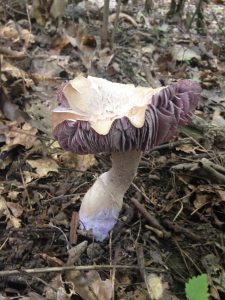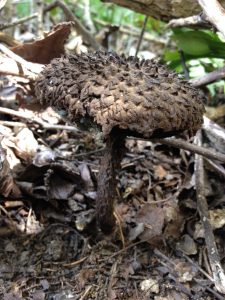Southern Illinois’ Woodlands Have Plenty of Room for Mushrooms
A favorite quarry of some hunters in southern Illinois is not a deer or turkey, but morel mushrooms. Most people are quite familiar with morels—that golden hued, sponge shaped delicacy. Mushroom hunters have their favorite woodland spots for hunting them for they know that mushrooms and trees go together in multiple ways. Mushrooms grow on dead wood. They grow on living trees. They grow above tree roots. What mushroom hunters probably don’t know is this: without fungi, most trees would die for lack of water and nutrients.
More than a century ago, scientists learned that microscopic threads of fungi attached themselves onto certain tree roots and formed life partnerships essential for both plant and fungus. This underground spiderweb of fungal threads is what delivers key nutrients and water the trees can’t easily extract or manufacture by themselves. The fungi, in exchange, having no internal energy source, siphon some of the tree’s plentiful sugars as food. This relationship is called mycorrhiza.
However, not all fungi have a mycorrhizal relationship with trees. Some fungi play a critical recycling role—tearing apart dead tissue of fallen trees, leaves and withered annual plants and using the leftover nutrients for the benefit of themselves and new forest life. No one fungus does it all. In fact, individual species of fungi show up to do their work only at certain places and stages of decomposition.
One fungus might work on the stems of dead walnut leaves and another might dissolve the thin tissue between the veins of dead leaves. A forest might host thousands of species of fungi, each performing a job others do not. Some fungi compete against other fungi with brutal chemical warfare for the same resources, while other ignore the meaningless presence of a fungal relative.
Let’s take a look at some of the less common mushrooms that can be found in the area:

Chicken-of-the-Woods. Photo courtesy Joann Fricke.
The Chicken Mushroom, sometimes called Chicken-of-the-Woods, can be recognized from a long distance by its eye-catching hue of yellow-orange. From late April through October, watch for living or dead hardwoods to erupt with massive fruitings of these overlapping, shelf-like lobes. It is edible and is best eaten when fresh, even then sometimes producing unpleasant reactions after consumption, such as nausea and skin rashes.

Coral Mushroom. Photo courtesy Joann Fricke
In the Ozarks, Coral Mushrooms are found in oak/hickory forests and along their edges. They are obviously named for their resemblance to coral found in the ocean. Typically, corals are in abundance during the months of September and October, depending on moisture and temperature levels. There are numerous species of coral mushrooms throughout the U. S. Most corals are completely edible, but some may not taste very good and others may cause gastrointestinal distress.

Purple-Gilled Laccaria. Photo courtesy Joann Fricke.
The Purple-Gilled Laccaria can be found in late summer and early autumn. The cap of this mushroom looks somewhat like a helmet when young, is 1 to 4 inches across and is often small in comparison to its stem size. In maturity, thin edges of the cap roll inward, often with an irregular, wavy shape. The most interesting feature of this mushroom is the beautiful violet to purple color of the gills.

Old-Man-of-the-Woods. Photo courtesy Joann Fricke
A most unusual mushroom is the Old Man of the Woods. There simply aren’t any other mushrooms out there like it. The cap of the Old Man of the Woods is fairly large, 3 to 6 inches across when mature, and covered with a thick mat of wooly fibers that splits into a mosaic of irregularly arranged, angular portions as the mushroom grows. When very young, the dense, convex cap is dark, nearly black. However, that darkness splits open to reveal the white, woolly fibers as the cap expands. Eventually, everything on the cap turns dark brown, nearly black.
Chanterelles are in season all summer and are highly valued by great chefs everywhere. They come in a variety of colors: yellow, red and the black trumpet. Yellow Chanterelles feature a yellowish orange to gold cap that is 1 to 3 inches across. When young, the cap is like an acorn cap—with the edge rolled slightly over itself. In maturity, the cap often flares upward like an umbrella in a windstorm, revealing the gill-like ridges below.
Red Chanterelles have a fairly small, bright red to orange red cap that is often no larger than one inch across. When young the dome-shaped cap curls over the stem, but soon flares up into a vase shape, exposing the forked, wrinkled gills below.
The Black Trumpet Chanterelle has a brown to black funnel shape constructed of thin tissue, but lacks a proper cap. The entire mushroom is simply a hollow funnel, usually 1 to 3 inches tall, with the upper portion flaring outward. The Black Trumpet is different from other chanterelles in that it has no gills. Instead, the exterior, spore-bearing surface of this trumpet-shaped mushroom is basically smooth.
Now let’s circle back to those beloved morels. The website illinoismushrooms.com has a section devoted to unusual places where morels have been discovered. One story tells of an elderly woman who anticipated finding a plethora of morels in the spring at the base of an elm tree that had been destroyed in a storm the previous year. She had been told to expect good things when the tree died. She was disappointed to find no morels growing where the dead elm stood, however, several feet away near a row of peonies, she found over 30 large morels! No one had predicted that.
In another story from this website, a southern Illinois couple woke one morning to find 3 morel mushrooms growing out of a crack in the concrete steps right outside their front door. Non morel eaters, rather than harvesting them, the couple let the novelties remain until they dried up.
If you hunt mushrooms to eat them, please research their edibility thoroughly. There are many look-alikes that, when consumed, will not produce pleasant results. Some are even life threatening. As the old saying goes, “Better safe than sorry.”
CLIFFTOP, a local nonprofit organization, is focused on preserving and protecting area blufflands.
A version of this article appeared in the November 2, 2018 edition of the Monroe County Independent.
©2018 all content rights reserved Clifftop NFP
Comments are currently closed.
